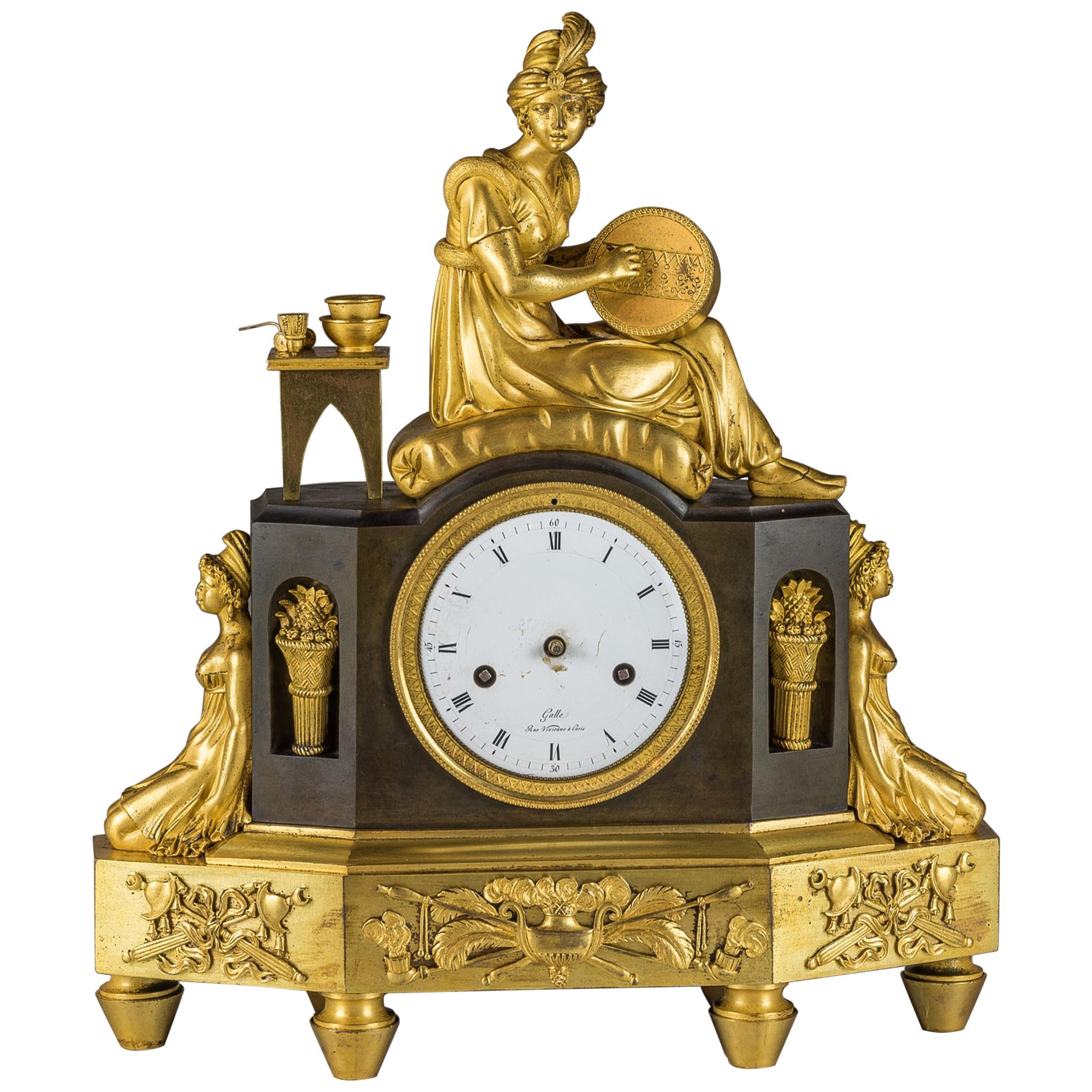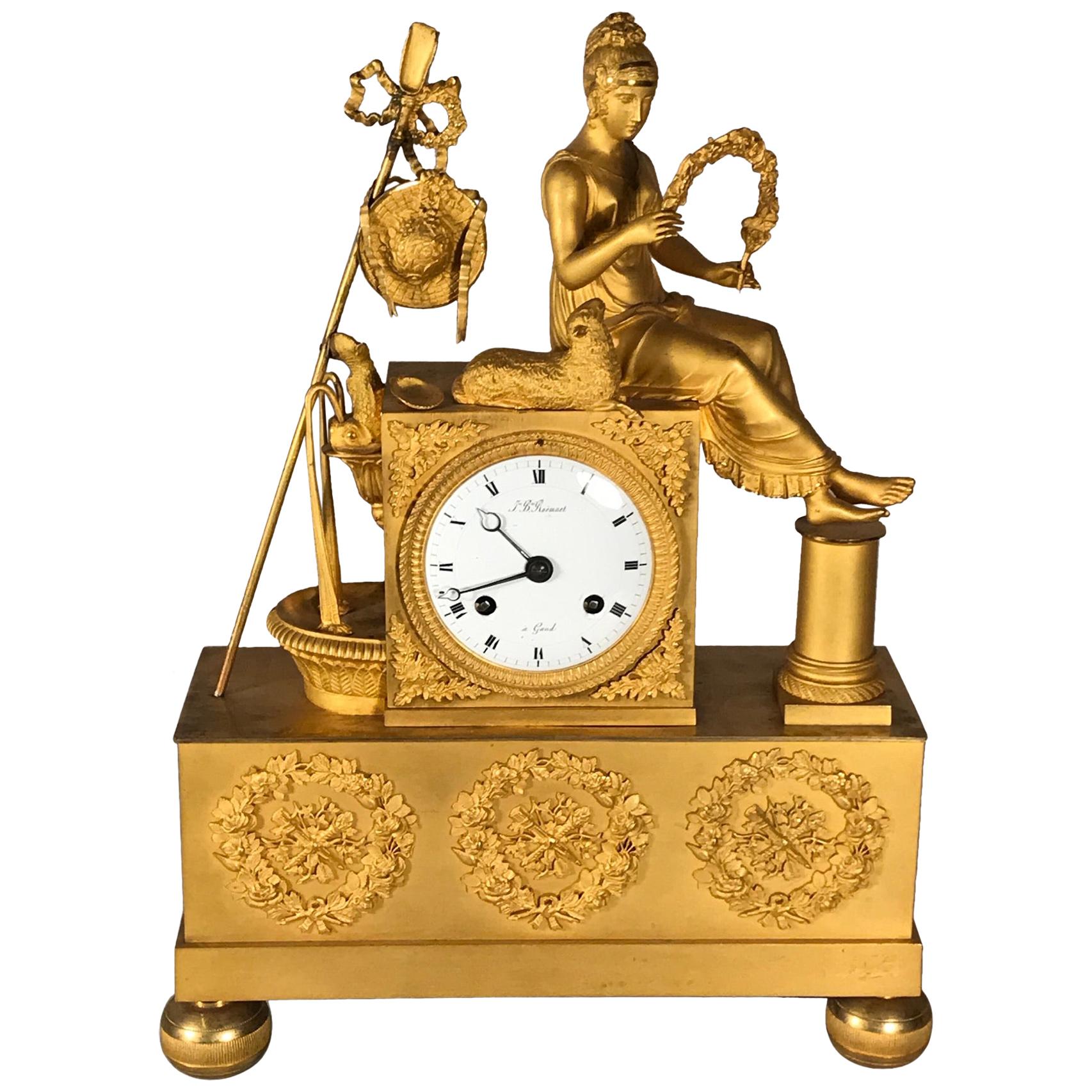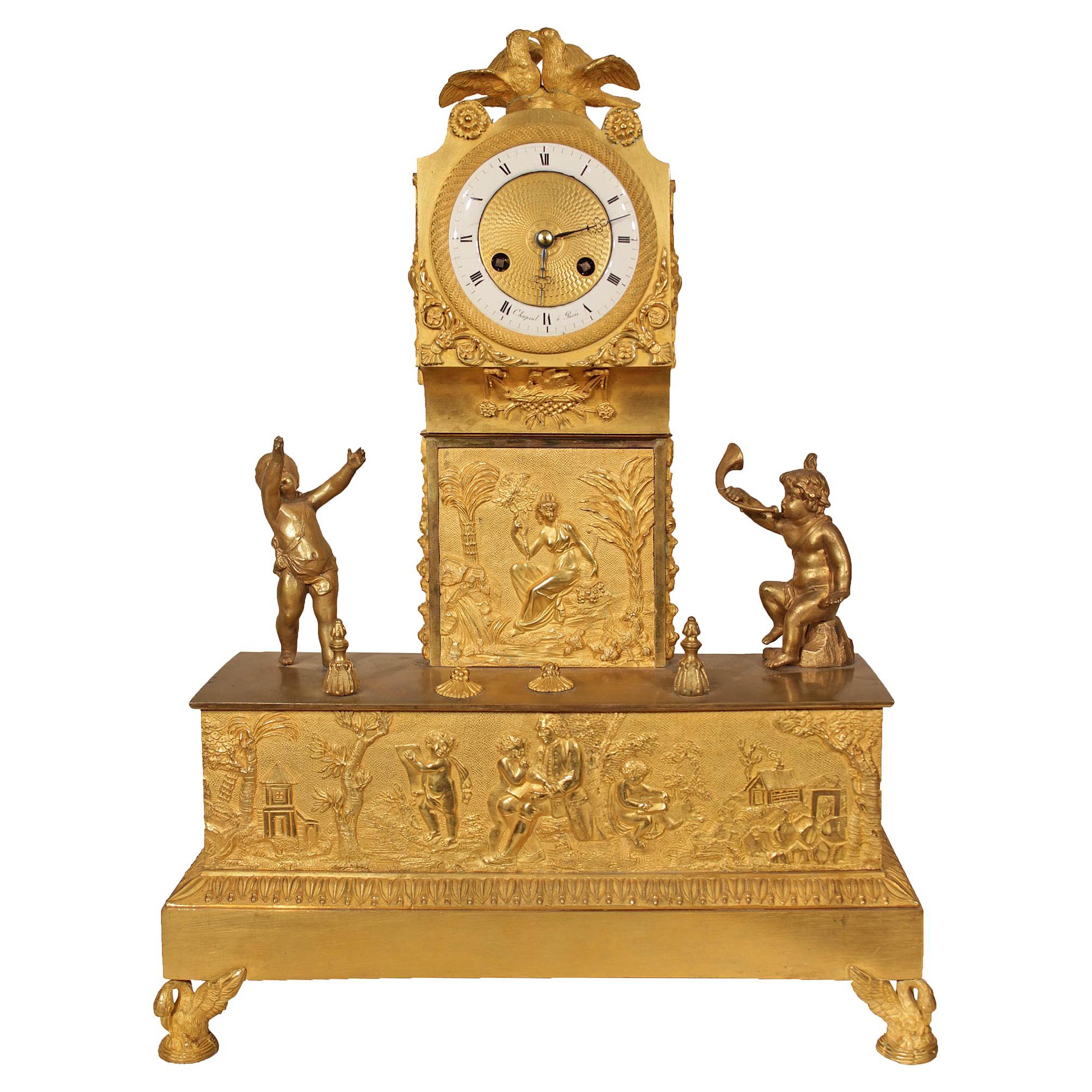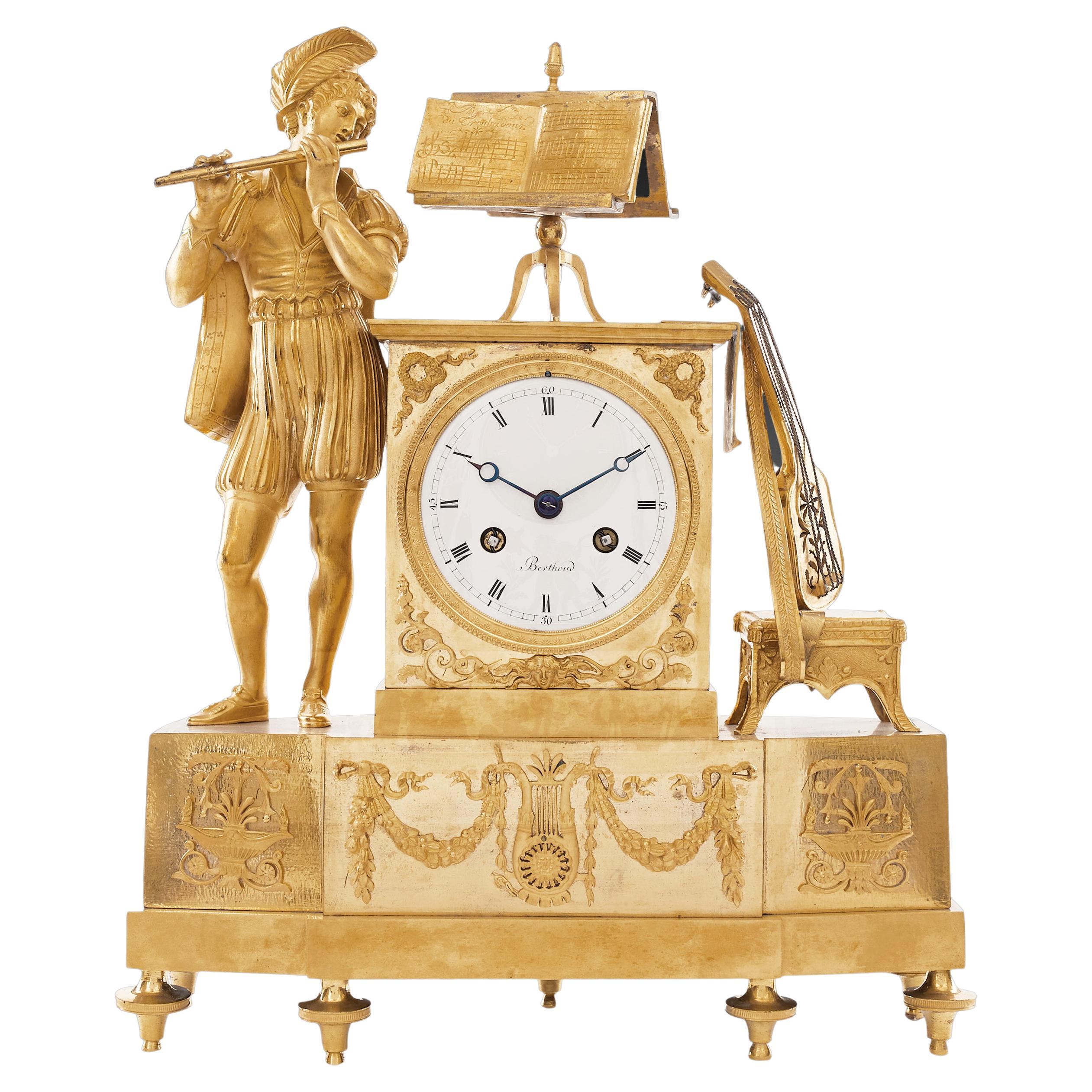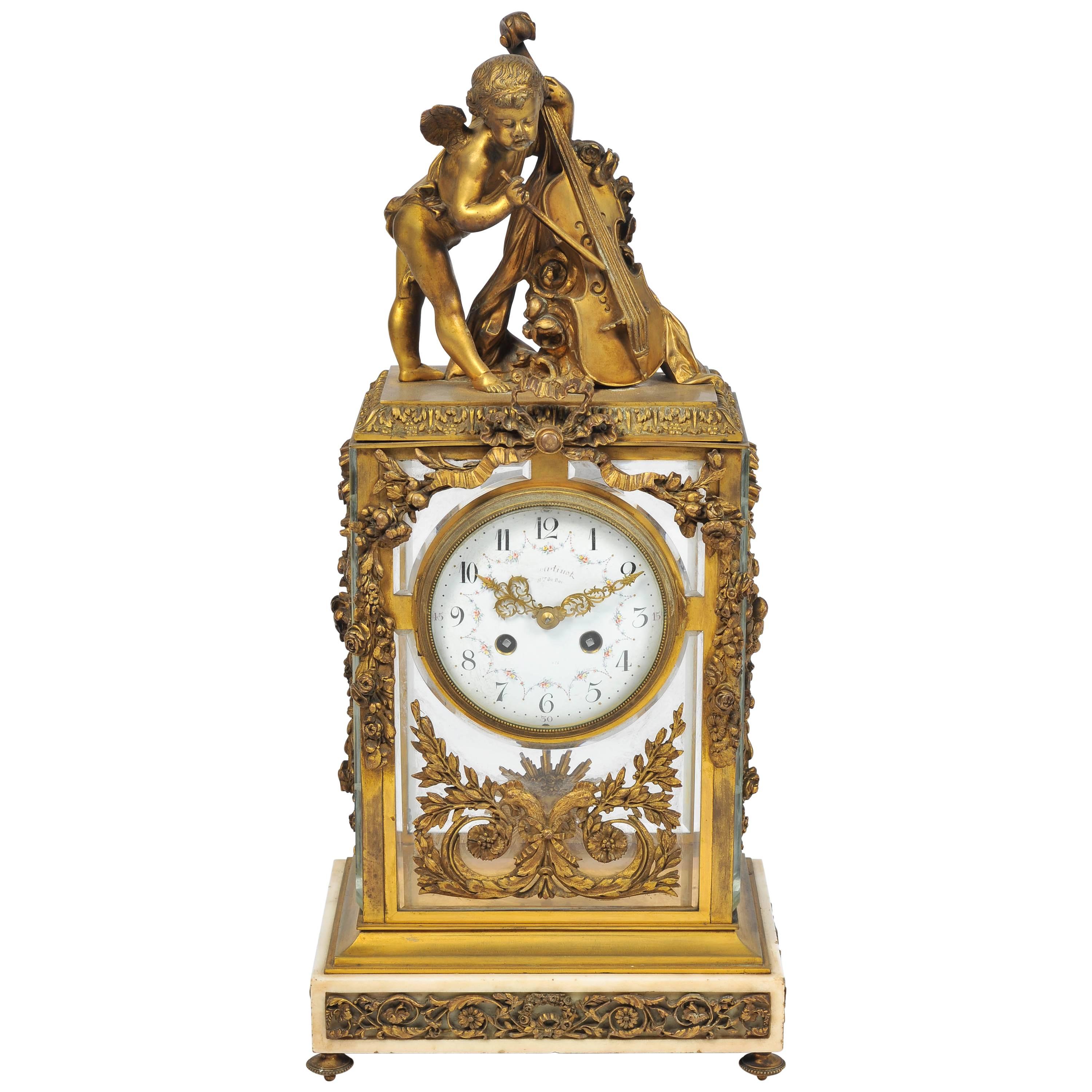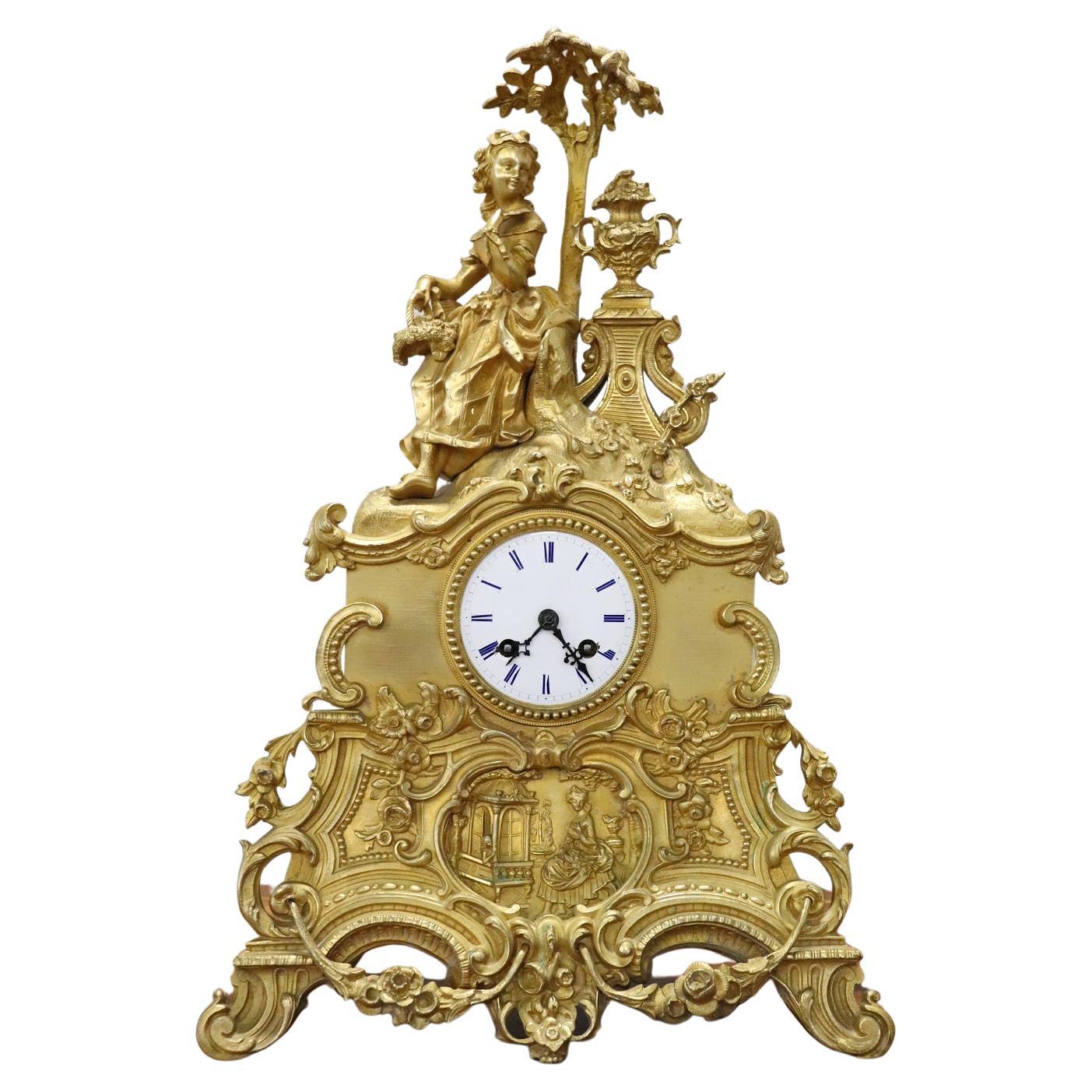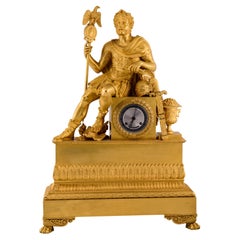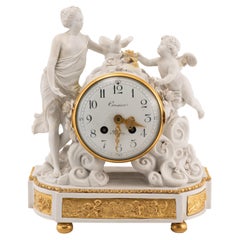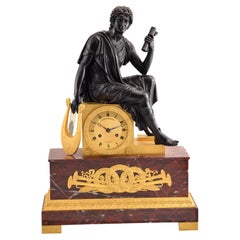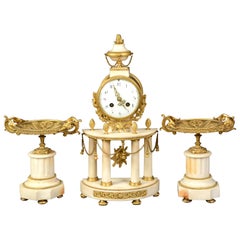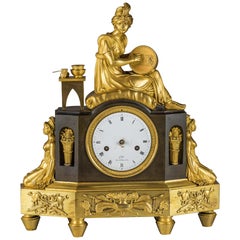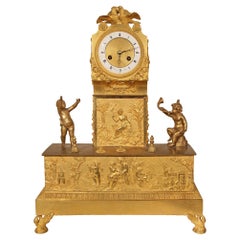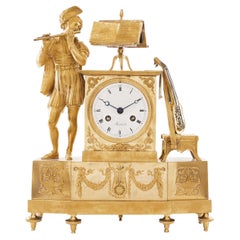Items Similar to Table Clock, Ormolu, 19th Century
Want more images or videos?
Request additional images or videos from the seller
1 of 8
Table Clock, Ormolu, 19th Century
$3,595.85
£2,689.93
€3,000
CA$4,950.72
A$5,417.97
CHF 2,862.92
MX$64,667.07
NOK 36,534.46
SEK 33,413.73
DKK 22,856.61
About the Item
Table clock made of gilded bronze with a powerful base, enhanced with legs decorated with vegetal and architectural motifs of classicist inspiration and a series of details on the front (volutes in the chamfered corners, volutes and a center with a globe from which light radiates and a parchment, with inscriptions in both), as well as bands of simple architectural elements and smooth spaces to enhance those decorations. On this pedestal has been placed a parchment for the sphere (white, with Roman numerals for the hours and lines for the minutes, breguet-type needles), surrounded by a garland. In this area there is a male figure, dressed in suits reminiscent of the Renaissance, holding a drawn sword; In addition, a series of elements have been placed on the part of the sphere (a terrestrial globe, documents with cursive texts in French, etc.). The allusion to the sciences is clear when presenting at such a prominent point the documents with the respective texts and the sphere. The detail of the sword refers to the war. Thus, it would be a figure that would unite wisdom and action, uniting in the gentleman of a certain age both, as it should be in a ruler or people of a certain social class. The best examples of bronze table clocks were made in France during the 19th century, or so it was considered. This is due to the care with which it was organized and legislated the manufacture of applications and elements in bronze, the gold bronze technique to mercury, and the participation in the creation process of front-line artists who were in charge of the designs of the figures and decorative motifs (likewise, it was not unusual to make figures inspired by or more directly copying great works of Art History). The resulting clocks were much appreciated, being destined to decorate interiors of palaces and outstanding residences.
Size: 43 x 17 x 55 cms.
- Dimensions:Height: 21.66 in (55 cm)Width: 16.93 in (43 cm)Depth: 6.7 in (17 cm)
- Style:Neoclassical (Of the Period)
- Materials and Techniques:
- Place of Origin:
- Period:
- Date of Manufacture:19th Century
- Condition:Wear consistent with age and use.
- Seller Location:Madrid, ES
- Reference Number:Seller: Zf02071stDibs: LU295139958353
About the Seller
4.9
Vetted Professional Seller
Every seller passes strict standards for authenticity and reliability
Established in 1985
1stDibs seller since 2017
357 sales on 1stDibs
Typical response time: Several days
- ShippingRetrieving quote...Shipping from: Madrid, Spain
- Return Policy
More From This Seller
View AllTable clock, Aníbal Barca. Ormolu bronze, metal. France, 19th century.
Located in Madrid, ES
Table clock, Aníbal Barca. Ormolu bronze, metal. France, 19th century.
Table clock with Paris machinery and a case made of mercury-gilded bronze. in mercury-gilded bronze, with a rectangular base on four rectangular base on four legs (the front ones decorated with scrolls and decorated with scrolls and ending in claws), decorated with a series of mouldings in relief with vegetal and architectural elements. vegetal and architectural elements in relief. The dial The dial (metal with Roman numerals for the hours) is set within a square shape, on which sits the male figure that decorates the piece. A bearded man, dressed in armour (a muscular loriga or cuirass) and a cape fixed over one shoulder with a fibula, resting his left arm on the helmet holding a rolled-up document, and with his left hand document, and with his left hand he holds a Roman standard (another Roman standard (another is broken, under his foot). Note, to the right and next to a sword, a vase full of rings.
vase full of rings.
Hannibal Barca (247-183 BC) was a Carthaginian general and statesman who was well known for his Carthaginian general and statesman, well known for his the ancient Roman Empire. No He was often depicted as counting the rings of fallen Roman knights in
the fallen Roman knights at the battle of Cannas (216 BC). , as can be seen in the sculpture by
sculpture by Sébastien Slodtz (made in 1704, Louvre Museum, Paris), where he also carries a Roman banner. Roman standard. With these two elements (vase with rings and with rings and a banner) is also shown on a table clock...
Category
Antique 19th Century European Neoclassical Revival Mantel Clocks
Materials
Bronze, Other
Louis XVI style mantel clock. Biscuit, metal, glass. Crosnier, Paris, France
Located in Madrid, ES
Louis XVI style mantel clock. Biscuit, metal, glass. Crosnier, Paris, France, circa 1900.
It has defects.
A table clock made of bisque porcelain with metal fittings, featuring a wh...
Category
Early 20th Century French Other Table Clocks and Desk Clocks
Materials
Other, Metal
Table Clock, Apollo, Bronze, Marble, Model of Lenoir-Ravrio, Louis-Stanislas
Located in Madrid, ES
Table clock, Apollo. Bronze, marble. Model of Lenoir-Ravrio, Louis-Stanislas(1783-1846). Paris, around 1820.
Table clock composed of a staggered rectangular base made of red veined...
Category
Antique Early 19th Century French Neoclassical Mantel Clocks
Materials
Bronze, Other
Louis XVI Style Clock Garniture, Gilt Bronze Marble, 19th Century
Located in Madrid, ES
Two cups on pedestals and a clock.
The French style known as Louis XVI is characterized by its inspiration in classicism and covers approximately from 1760 to 1789. In the 19th cent...
Category
Antique 19th Century French Louis XVI Garniture
Materials
Marble, Bronze
Wall clock. Gilt bronze. France, 19th century.
Located in Madrid, ES
Wall clock. Gilt bronze. France, 19th century.
Gilt bronze wall clock of the type known as a "cartel" due to its shape, featuring Parisian movement and a white dial with Roman numer...
Category
Antique 19th Century French Neoclassical Revival Wall Clocks
Materials
Bronze, Other
Louis XVI clock garrison and chandeliers. POCHON. Paris, circa late 18th century
By Jean Charles Pochon
Located in Madrid, ES
Louis XVI clock garrison and chandeliers. Gilt bronze, marble. POCHON, Jean-Charles (act. last third of the 18th century). Paris, France, around 1780 or 1790 and later.
Bibliography:...
Category
Antique Late 18th Century French Louis XVI Mantel Clocks
Materials
Marble, Bronze, Other
You May Also Like
French Empire Ormolu Figural Mantel Clock
Located in New York, NY
The enamel dial signed 'GALLE RUE VIVIENNE A PARIS’
Movement: Claude Galle (1759-1815)
Origin: French
Date: 19th century
Size: Height 14 x 12 x 4 3/4 inches
Claude Galle ...
Category
Antique 19th Century French Mantel Clocks
Materials
Bronze
Ormolu Mantel Clock, Belgium, circa 1810-1820
Located in Belmont, MA
Empire ormolu mantel clock, Belgium, circa 1810, Signed "J.B. Romaet a Gand". Decorated with a shepherd scene. Strikes the hour and half hour on a bell. With enamel clock face and si...
Category
Antique 1810s Belgian Empire Mantel Clocks
Materials
Ormolu
French 19th Century Louis XVI St. Ormolu Mantel Clock
Located in West Palm Beach, FL
A spectacular and unique French early 19th century Louis XVI st. ormolu mantel clock, signed by Chapsal a Paris. The clock is raised on finely chased swan supports below a rectangula...
Category
Antique 19th Century French Louis XVI Mantel Clocks
Materials
Ormolu
Mantel Clock 19th Century Styl Empire by Ferdinand Berthoud À Paris
Located in Warsaw, PL
Ormolu bronze mantel clock flanked by a troubadour and musical instruments, signed 'Ferdinand Berthoud a Paris'.
The end of the 18th and beginning of the 19th century was a crucial time in which new technological advances helped to make watches more accurate and more portable. During the 1790s, the production of gilded bronze increased considerably as working conditions improved. The freedom of trade initiated by the French Revolution allowed many casters to develop large factories. The new factory environment gave them a chance to execute all stages of bronze work including drawing, casting, gilding, assembly, and trade of art objects. While the bronzers took creative liberty in creating all kinds of clocks in contrast to the noble and rigorous structure carried by the movement of neoclassicism. Under the reign of Empire, the case designs started gradually to develop away from a proportionate and strict classicism towards a baroque style and revival style. The rediscovery of medieval civilization was one of the intellectual curiosities of the beginning of the 19th century, with much input from the Ancien Régime and its institutions, rites and the medieval churches in which family ceremonies occurred.
This early nineteenth-century figural mantel clock is surmounted by a medieval musician. To be more precise, it is a french troubadour. Troubadours were known for composing and performing lyric poetry for the nobility back during medieval times. The clock is featuring a chiselled bronze troubadour, dressed in medieval fashion while holding a flute, playing a tune from sheet music called "Du Troubadour" that is resting on top of the rectangular clock case. In addition to that, the clock features a gilt bronze lute or vielle resting on a small stool on the opposite side of the clock’s case. The white enamel dial features the inscription Berthoud and is underlined by a bronze entourage chiselled with palmette motif, plus encompassed by c-scrolls and wreaths. The original hands are in blued steel and encircled by Roman numerals indicating hour next to Arabic numerals indicating minutes.
The small details that adorn the hexagonal plinth are reliefs, depicting two water fountains or basins on both sides with a lyre in between. The sculpted image of a lyre raised above the background features also foliage garlands tied on top with ribbons. The clock rests on seven spinning feet.
The clock was made in the well-known workshop of the Berthoud’s family that was recognized for their excellent work by the King.
Berthoud Clockmakers History.
Ferdinand Berthoud was a horologist and author of extensive treatises on timekeeping as well as a Swiss clockmaker serving the king of France, that produced many marine clocks, including a weight-driven version that inspired the first American sea-going clock. He was born in Plancemont, Switzerland, the son of an architect and judiciary. In 1741 he began a three-year apprenticeship as a clockmaker under his brother, Jean-Henri. He made his first marine chronometer in 1754 (sent for trial in 1761) and in 1764 was appointed a member of the Royal Society, London and Horloger Mécanicien de Sa Majesté et de la Marine ayant l'inspection de la construction des Horloges Marines. In 1769, Ferdinand Berthoud sent for his nephew Pierre-Louis Berthoud (1754–1813), commonly known as Louis Berthoud, a talented young watchmaker and clockmaker, inviting him to come to Paris from Couvet, Switzerland, to pursue his apprenticeship. Louis helped Ferdinand manufacture and repair the sea clocks...
Category
Antique Late 18th Century French Louis XVI Mantel Clocks
Materials
Bronze
19th Century Louis XVI style, Mantel Clock 17"(43cm)
Located in Brighton, Sussex
A very good quality 19th Century French gilded ormolu mantel clock. Having a cherub playing a base violin, a four glass case mounted with ormolu foliate and swag decoration, an eight...
Category
Antique 19th Century French Mantel Clocks
Materials
Ormolu
19th Century Ormolu Gilt Bronze Antique Table Clock
Located in Casale Monferrato, IT
Rare antique 19th century table clock in ormolu gilt bronze. Characterized by a refined decoration chiseled in bronze, in the upper part a s...
Category
Antique 1880s Italian Table Clocks and Desk Clocks
Materials
Bronze
$2,684 Sale Price
20% Off
More Ways To Browse
Antique Light Globes
Pendule France
Antique French Clock Movement
Art Deco Onyx Clocks
Bear Clock
Lion Clock
London Brass Clocks
Roman Keys
Boudoir Clock
Clocks Circa 1860
Pink Antique Clock
Wind Antique Clock
19th Century Swiss Clocks
19th Century Tiffany Bronze
Antique Clock With Cherubs
Black And Ormolu Clocks
French Cherub Mantel Clock
Museum Clock
